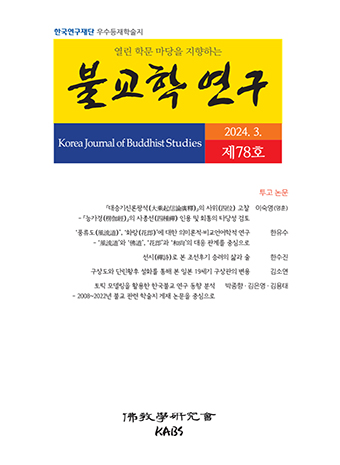Abstract
References
Sorry, not available.
Click the PDF button.
Information
This paper deals with the doctrines regarding bodhisattva ideal and bodhisattva stages in Saṃdhinirmocana Sūtra and it’s commentary by Wonchuk. This Sūtra defines bodhisattva as one who attains paramārtha-satya, knows dharma-śūnyatā, loses great arrogance, knows well citta, ādāna-vijñāna and ālaya-vijñāna, also recognizes ‘the three natures’―parikalpita svabhāva, paratanatra svabhāva and pariniṣpanna svabhāva. Bodhisattva ultimately realizes the three kinds of naturelessness―the naturelessness of characteristics; the naturelessness of birth; naturelessness of the ultimate truth―and transfers his merit to living beings for their benefit. As Bodhisattva’s practice, Saṃdhinirmocana Sūtra emphasizes śamatha vipaśyanā, cutting kleśa and ten pāramitās. Ten pāramitās consist of six pāramitās and other four virtues―upāya kauśala pāramitā, pranidhāna pāramitā, bala pāramitā and jñāna pāramitā. Bodhisattva’s stages are very simply explained in terms of the ten bhūmis, which are similar to those of Mahāvaipulyabuddhāvatamsaka Sūtra. Another characteristic of bodhisattva is the ideal of One Vehicle which does not distinguish Great Vehicle and Lesser Vehicle. Therefore every śrāvaka, pratyekabuddha and bodhisattva could attain nirvāṇa according to the teachings of this Sūtra. This characteristic is unique to Saṃdhinirmocana Sūtra which is different from both the theory that only bodhisattvagotra can attain nirvāṇa and the theory that all sentient beings can attain nirvāṇa. In Saṃdhinirmocana Sūtra, Yogācāravijñānavāda eventually reorganizes the doctrine of bodhisattva from the view of Yogic Practice.
Click the PDF button.
- Publisher :Korean Association of Buddhist Studies
- Publisher(Ko) :불교학연구회
- Journal Title :Korea Journal of Buddhist Studies
- Journal Title(Ko) :불교학연구
- Volume : 15
- No :0
- Pages :271~301


 Korea Journal of Buddhist Studies
Korea Journal of Buddhist Studies






